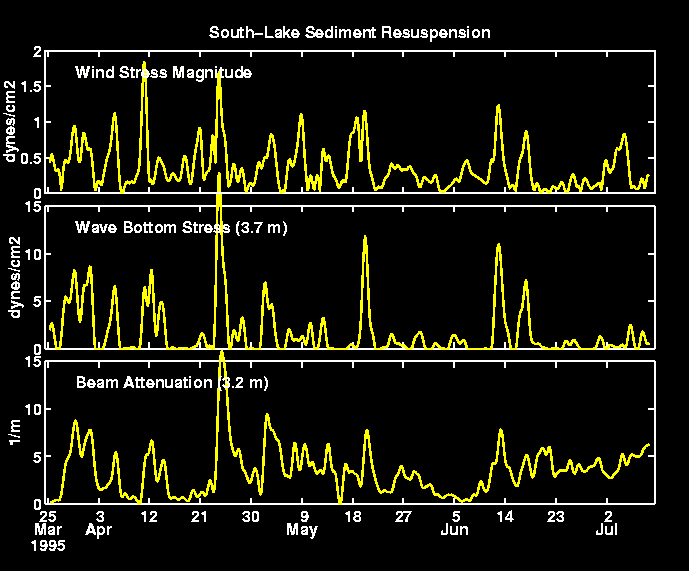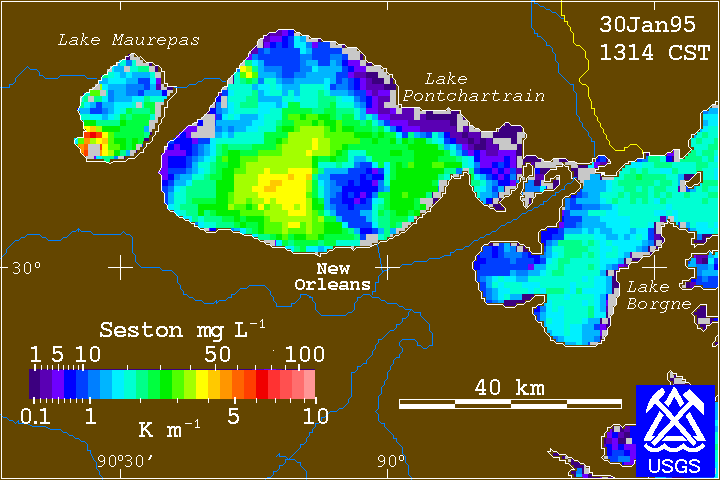
Wind Driven Circulation and Sediment Resuspension Processes in Lake Pontchartrain, LouisianaRichard P. Signell, Jeffrey H. List, Richard P. Stumpf and John EvansTwo critical processes related to sediment transport in Lake Pontchartrain are the
resuspension of sediments due to wind generated storm waves and the transport of
resuspended material during strong wind events. The USGS is studying these processes with
a combination of in situ data, numerical modeling and remote sensing.
During the 1998 deployment, turbidity, waves and currents (as well as temperature and salinity) were recorded at two depths at each of two sites in the central and south lake. Initial findings are the lake does exhibit the double cell circulation pattern in response to wind that is predicted by the model (see circulation modeling sections below). Modeling: The potential for sediment resuspension was studied using a wave prediction model HISWA (HIndcasting Shallow water WAves, Holthuijsen et al., 1989) which simulates local generation of waves by wind and shallower effects on waves (refraction, shoaling, bottom friction, and breaking). Long-term wind measurements were then used to determine the regional "climate" of bottom orbital velocity; the spatial and temporal variability of wave induced currents at the bottom (Figure 3). Comparisons of the wave model to the 1995 wave observations were excellent. (Figure 4). The circulation of the lake is being studied with the three-dimensional hydrodynamic model of Blumberg and Mellor (1987). Results of this modeling effort indicate that remote forcing due to water levels in Mississippi Sound dominate the circulation near the passes in the eastern end of the lake, while local wind forcing dominates water movement in the western end. As lake levels rise, water enters the lake from the eastern entrances and generates significant westward flows, as much as 10-20 cm/s. Eastward flows are driven by falling lake levels. The model also predicts a two gyre response driven by winds over the lake, with downwind transport along the periphery of the lake and upwind in the deeper central lake (Figure 5). Thus during typical storms with winds from the north-northeast or the south-southeast, currents along the south coast near New Orleans generally transport material westward, while material in the central region moves eastward against the wind. The current meter data collected 1998 will be used to assess the wind response predicted by the circulation model. FLC ANIMATION OF 1995
Using 5 years of sea surface reflectance data as a indicator of turbidity, we hope to determine the relationship between turbidity and bottom stress (predicted from the wave model) throughout the lake and as a function of season. Water property data from the Louisiana Department of Environmental Quality (pers. comm.), obtained via monthly sampling from the Causeway, is being used to ground truth the remotely-sensed turbidity.
REFERENCES CITED Blumberg, A.F. and G.L. Mellor, 1987, A description of a three-dimensional coastal model, in N.S. Heaps, ed., Three-Dimensional Coastal Ocean Models: Coastal and Estuarine Sciences #4, American Geophysical Union Press, Washington D.C., p. 1-16. Holthuijsen, L.H., N. Booij, and T.H.C. Herbers, 1989, A prediction model for stationary, short-crested waves in shallow water with ambient currents: Coastal Engineering, v.13, p. 23-54. Signell, R.P. and J.H. List, 1997, Modeling Waves and Circulation in Lake Pontchartrain, Gulf Coast Association of Geological Societies Transactions, v 47, p 529-532. Stumpf, R.P., 1998, Satellite Imagery of the North-Central Gulf of Mexico, June 1993 - May 1997. OFR 98-484. CD-ROM.
|
||||||||||||||





